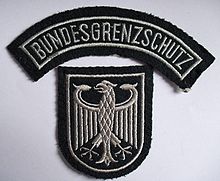Compulsory Border Guard Service
This article needs additional citations for verification. (September 2018) |

press gang |
|---|
| Related concepts |
| By historical country |
| By modern country |
| By geographical area |
The Compulsory Border Guard Service (German: Grenzschutzdienstpflicht) was enacted by the German parliament in the Federal Border Protection Act of 18 August 1972, based on Article 12a of the German Constitution.[1] The remaining provisions of the Federal Border Protection Act were repealed in 1994.[2][3] However, compulsory border guard service has not been enforced since 1973. Anyone who serves or served in the Federal Border Guard (German: Bundesgrenzschutz (BGS)) can no longer be assigned to the military service (§ 42a Conscription Law) in the German Federal Armed Forces (German: Bundeswehr). In 2005 the border guard was renamed the Bundespolizei (BPOL) (Federal Police) and any mandatory service would be performed there.[4][5][6]
History
The implementation of compulsory border guard service has to be seen in a historical context. Until the 1980s the BGS was organized as a
After the "
Drafting of Border Guards
Men at the age of eighteen, or older if they were former members of the Federal Police or if they had not previously served in the military or federal police, can be drafted to the border guard service. Mandatory service can be introduced if there are not enough volunteers joining the federal police. If the need is covered by volunteers at a later date, currently drafted persons are to be released. The employment status of the draftees is similar to the status during military service. The service is divided into border protection basic service, border protection exercises and perpetual border protection service in case of defense and in the cases mentioned in article 91 of the constitution. After their service has been completed, members are transferred to the border guard reserve.
Current enforcement of the draft
Similar to the suspended conscription for military service since 2011, the compulsory border guard service is legally paused since 1994, but can be reactivated anytime by a resolution of the parliament.
See also
- Border guards
- Border guards of the inner German border
- Civil conscription
- Internal Troops
- Law enforcement in Germany
References
- ^ "Bundesgesetzblatt".
- ^ "§ 50 BGSG, Beginn und Ende der Grenzschutzdienstpflicht". Archived from the original on 2018-11-16. Retrieved 2018-11-15.
- ^ "BGSG - nichtamtliches Inhaltsverzeichnis".
- ISBN 9783663130871.
- ^ http://dipbt.bundestag.de/doc/brd/1994/D840+94.pdf [bare URL PDF]
- S2CID 163248420.
